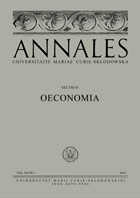Determinants of Unemployment in Peripheral Regions of Eastern Poland in 2008–2019
Determinants of Unemployment in Peripheral Regions of Eastern Poland in 2008–2019
Author(s): Mateusz Biernacki, OLEKSIJ KELEBAJ, Magdalena Lubaś, MARCIN RYCHLAKSubject(s): National Economy, Socio-Economic Research
Published by: Wydawnictwo Naukowe Uniwersytetu Marii Curie-Sklodowskiej
Keywords: determinants of unemployment; labour market; spatial variation;
Summary/Abstract: Theoretical background: The origin of spatial variation in unemployment in Eastern Poland is related to the country’s system transformation, with regions that relied historically on state agricultural farms and industrial plants experiencing more challenging labour market conditions. The labour market is hetero- geneous, and three approaches prevail regarding the origin, occurrence, and persistence of imbalance in the labour market: structural and institutional factors, long-term adaptation processes, and wage rigidity. While economic growth is a necessary condition for reducing unemployment, a rise in the economic growth rate does not necessarily lead to increased employment until a certain GDP growth threshold is exceeded. Purpose of the article: This study aims to conduct an empirical analysis of unemployment determinants in the Eastern region of Poland at the LAU-1 level. Research methods: The study is based on the analysis of the equation that was adopted from unemploy- ment rate definition. Analysis of relation between unemployment rate, growth rate of labour supply and unemployment rate in previous period, using regression models, has been calibrated using government data from five provinces of Eastern Poland, covering the period from 2008 to 2019. Main findings: The results of the analysis show an improvement in the labour market situation during the analysed period, which is associated with the overall economic growth in Poland. The economic conditions favoured the improvement of employment indicators, corresponding to the increasing level of education in the population. The economy during the study period was characterized by stable GDP growth and decreasing unemployment rates. Similar trends were observed in the Eastern region of Poland, although the values of industrial production growth were slightly lower due to the local employment structure and regional industrial diversity. The analysis showed that a higher initial level of unemployment has a significant impact on its re- duction in subsequent years. The significant impact of economic growth on reducing unemployment rates was also confirmed, especially in the category of people with lower vocational education. The study indicates the need for actions aimed at raising the level of education of people of working age, including through lifelong learning programs and active prevention of skill mismatch in the labour market. This study has limitations due to the number of analysed unemployment determinants and the limited time window of the study. Further research is necessary on the factors influencing unemployment at the regional and urban levels, taking into account the demographic structure of the population, employment quality, and gender-related aspects.
Journal: Annales Universitatis Mariae Curie-Skłodowska, Sectio H Oeconomia
- Issue Year: LVIII/2024
- Issue No: 1
- Page Range: 23-39
- Page Count: 17
- Language: English

